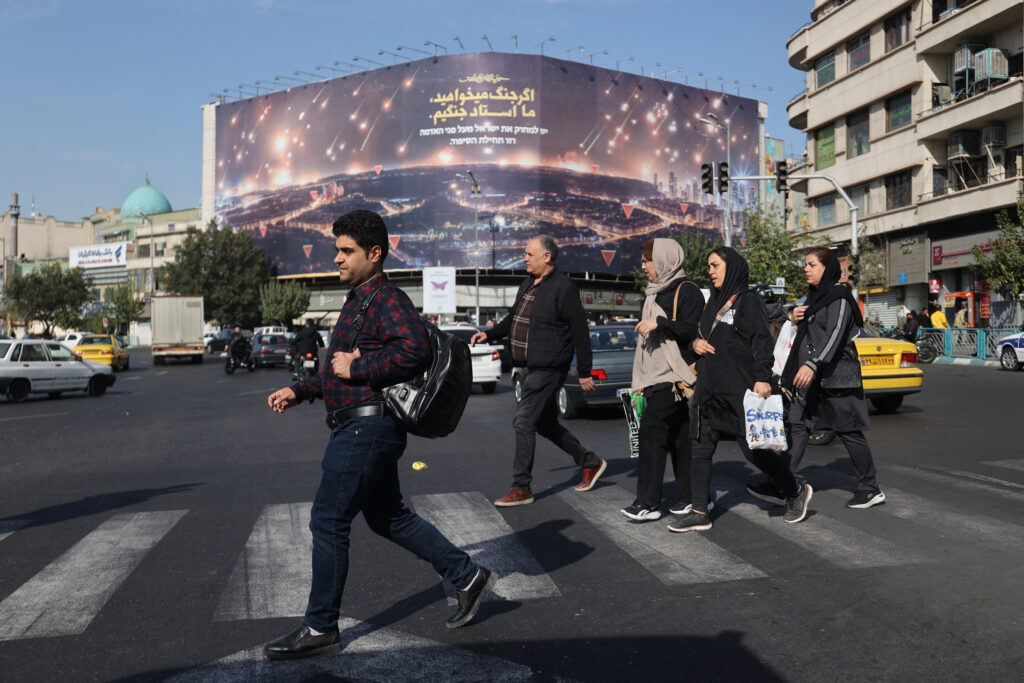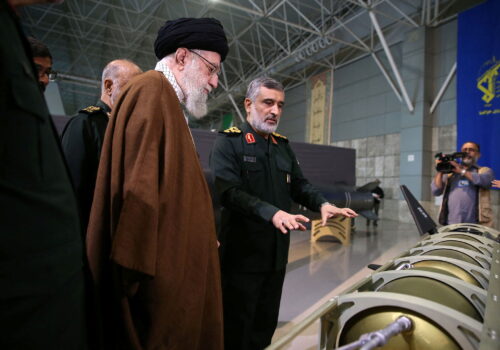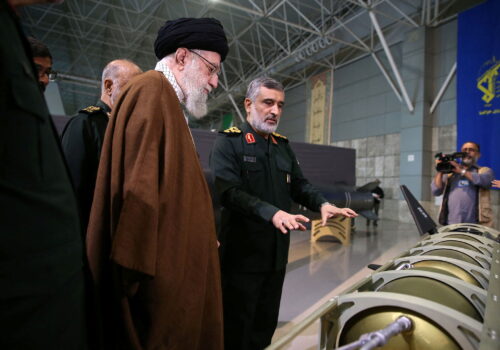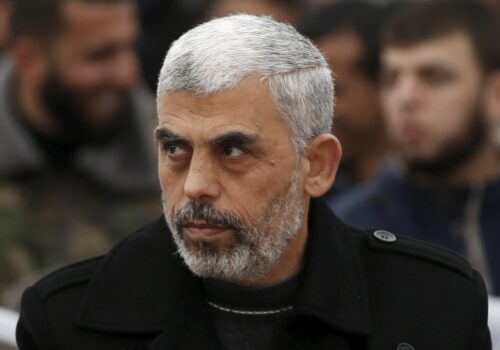
Experts react: Israel has hit back at Iran with airstrikes. Is this the road to war or an off-ramp?
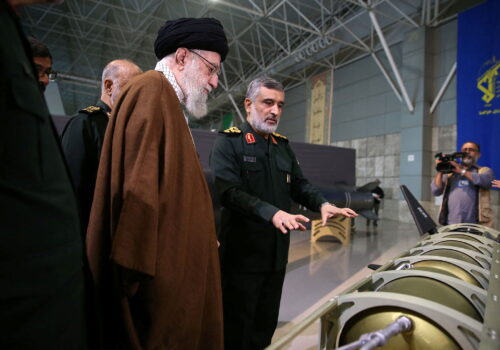
“Lethal, precise, and above all, surprising.” That’s how Israeli Defense Minister Yoav Gallant earlier this month described the strikes that Israel would launch against Iran in retaliation for Tehran’s October 1 ballistic missile attack against Israel. In the predawn hours on Saturday, Israel launched a series of airstrikes against Iranian military infrastructure in and around Tehran, Karaj, and Mashhad, killing at least four Iranian soldiers. Syrian state media reported additional strikes on military facilities in Syria, which Israel did not confirm. What do these strikes mean for the prospect of further escalation between Iran and Israel? How might Iran respond? Below, our experts explore what’s next.
Click to jump to an expert analysis:
Jonathan Panikoff: This time, the US swayed Israel not to go big. Now Iran may look for an off-ramp.
Kirsten Fontenrose: Israel and Iran both want to move on and return to proxy war
Holly Dagres: As Iranians downplay the attack, deterrence may have been restored
Thomas Warrick: Scenes of normal life in Tehran tell you all you need to know
This time, the US swayed Israel not to go big. Now Iran may look for an off-ramp
The United States did not partake in Friday night’s strikes on Iran, but its impact on the targets Israel struck is clear. Israel’s decision not to hit either Iran’s nuclear program or its oil and energy infrastructure was a key requirement of Washington’s, which continues to seek to avoid a broader regional war. In return, the United States deployed the THAAD anti-missile system to Israel and sent F-16 fighter jets to the region, to participate in a potential defense of Israel if Iran responds.
In Israel’s immediate neighborhood, and against terrorist targets—Hamas, Hezbollah, Shia militants in Syria—Israel has been far less forthcoming and willing to heed US military and strategic advice, even as it still lacks a clear endgame in Gaza or Lebanon. But in Iran, it was always going to be a different story. Could Israel have struck Iran even harder, and with much greater lethality and destruction, including going after its nuclear sites and energy infrastructure? Absolutely, and it still may if the conflict escalates. But to truly diminish the threat from Iran requires a long-term cohesive strategy, not a single night of strikes.
The question now is what will Iran do next? Tehran is in a lose-lose predicament—again. It has already promised a harsh response if Israel struck, and this morning reinforced its right “to defend itself.” But it has significant incentives to not let its actions match its bluster.
Israel’s strike against Iran in April, its killing of Hamas leader Ismail Haniyeh in Tehran at the end of July, its strikes against Hezbollah over the past three months, and its attack last night will reinforce to Iran that it is overmatched militarily, which, for a regime that prioritizes stability above all else, makes entering into a full-scale war an illogical choice. Moreover, Iran’s proxy network—from Hezbollah to Hamas to Shia militants in Syria and Iraq—has been diminished the past few months, and Iran is unlikely to want to accelerate the weakening of its own front lines of defense.
There remains significant potential for miscalculations or mistakes that could still lead to a broader war. But Israel’s attacks, which may continue in different guises, were clearly calculated and targeted. Their impact may be significant. But if Iranian officials downplay them—and reports they claimed to have successfully countered the attack are a good start—consider it a signal that Tehran is looking for an off-ramp, even if it claims otherwise. Iran may be frustrated that its deterrence against Israel has waned, but it’s unlikely to be temerarious in trying to restore it.
—Jonathan Panikoff is the director of the Atlantic Council’s Scowcroft Middle East Security Initiative. He is a former deputy national intelligence officer for the Near East at the US National Intelligence Council.
Israel and Iran both want to move on and return to proxy war
Israel knows its proportional and limited strikes on Iran effectively kick the can down the road. Iranian leaders will message to their supporters that they successfully defended against Israel’s aggression and will continue to pursue their stated objective of driving Israel out of the region. Israel will deal with Iran another day. Right now, Israel needs to focus manpower and munitions on dismembering Hamas and Hezbollah. Of course, putting Israel in the position to have to make this decision is a quasi-win for Tehran, where the regime’s strategy all along has been to have Arabs fight for its cause.
While more robust retaliation options were hotly debated in Israel, the US election cycle made those options less attractive—the tyranny of timing. Concerns about ballot recounts and legal challenges from both parties to US presidential election results, and uncertainty about the make-up of the Senate after November 5 , mean Israel could not confirm what level and speed of support it would receive if it retaliated in a way that sparked a wider, longer war. This uncertainty could also make Arab countries situated between Iran and Israel less likely to come to Israel’s defense, particularly after the overt threats politely delivered by Iranian Foreign Minister Abbas Araghchi in his recent tour through those states.
Israel’s strikes on Iran appear to have carefully avoided any civilian casualties. Targets were not located in densely populated areas, and unlike Hamas and Hezbollah, Tehran has not incurred many Israeli civilian casualties in its strikes on Israel. According to posts from private Iranian accounts on social media, many Iranians fear their own regime more than they fear Israel, and you can bet that inside Iran parts of the population are quietly celebrating Israel’s strike.
Without air defenses and munitions stockpiles immediately available, Iran is less apt to act against Israel directly in the near term. This means Israel’s military can focus on completing its missions closer to home. Iran’s proxies will have to go it alone; Tehran will not risk its own security for their sake. In the meantime, watch for the gloves to come off against the Houthis.
Hard-liners in Israel are enjoying Iran’s hyperbolic bluster about how little damage was done inside Iran and how ready the regime is to stage another attack on Israel at any time. Plans for more decisive blows to Iran’s leadership and capabilities were put back on the shelf last night, all tools intact, for use if and when necessary.
—Kirsten Fontenrose is a nonresident senior fellow at the Scowcroft Middle East Security Initiative in the Atlantic Council’s Middle East Programs. She was previously the senior director for the Gulf at the National Security Council.
Israel and Iran’s relative restraint could open the door to talks with Hamas and Hezbollah
News of Israel’s retaliation for Iran’s October 1 missile strikes raised four immediate questions:
- What message was intended? Was it meant to be a measured response that could be absorbed without escalation or one that communicated: “Fear us. We can reach anywhere, hit anything at will.”?
- Were Iranian Foreign Minister Abbas Araqchi and US Secretary of State Antony Blinken’s recent diplomatic swings helpful to maintaining the status quo after the Israeli operation?
- Were the strikes Israel’s last hurrah before Prime Minister Benjamin Netanyahu’s government returned to the negotiating table intent on reaching a deal to bring the hostages home?
- With Israel’s willingness to kill Hamas leaders and negotiators, who would or could safely step up publicly to negotiate on behalf of Hamas and Hezbollah?
We appear to have the answer to the first question. US redlines were maintained regarding nuclear and oil targets. And so far the Iranians, who can ill afford an escalation, are downplaying the impact, regardless of the reality of the damage done. They appear to be heeding the calls for restraint.
Diplomacy also appears to have notched a badly needed win. The United States was consistent in its messaging to the Iranians about Israel’s right to respond to the October 1 attack, and to Israel about the folly of striking too severe of a body blow against Iran. Regional actors continue to act responsibly.
On top of its lethal engagements with Hamas and Hezbollah, Israeli and likely Iranian restraint has opened an opportunity to successfully negotiate a hostage deal and a cessation of hostilities in Lebanon. Israel’s Lebanon campaign is not going as quickly as expected. And as casualties among the Israel Defense Forces mount and Hezbollah missiles still fly, Israelis may increasingly come to feel that the operation isn’t working as well as expected, either. As Israel has found consistently in the past, quelling aggression from Hezbollah always looks easier on paper than it proves to be in reality.
As with the previous exchange of strikes between Israel and Iran in April, the United States and Iran appear to be the grownups in the room, communicating intent as well as a lack of foreknowledge or responsibility to manage escalation as the frontline combatants endanger regional stability.
If empowered representatives of Hamas and Hezbollah exist, negotiators once again may have a chance in the coming days and weeks to save lives throughout the region. We’ve seen rounds end in failure after failure after failure. That’s the diplomats’ job. Push through failures until negotiations reach success.
—Gina Abercrombie-Winstanley is a nonresident senior fellow at the Scowcroft Middle East Security Initiative of the Atlantic Council’s Middle East Programs and at the Scowcroft Center for Strategy and Security. Abercrombie-Winstanley served as the US ambassador to the Republic of Malta and as special assistant for the Middle East and Africa to the secretary of state. Her Middle East assignments included election monitoring in the Gaza Strip and an assignment where she supported gender equality in the Kingdom of Saudi Arabia as the first woman to lead a diplomatic mission there.
As Iranians downplay the attack, deterrence may have been restored
Three young Iranian men stood on a rooftop with their hands to their heads as if searching. “Where is it? Nothing is happening,” one commented, their way of trolling the Israeli response. This video and ones like it from pro-regime social media accounts set the tone for how the Islamic Republic was interpreting the attack, at least on the surface level. They have been portraying the Israeli retaliation—despite the reported use of more than one hundred fighter jets in a three-wave attack—as not worthy of an Iranian response. In essence, deterrence appears to have been restored, yet again.
Flights continued to land and take off at Tehran’s Mehrabad and Imam Khomeini International airports, and there appeared to be no panic gas-filling at the gas stations, at least according to one video, all part of a narrative to suggest that it was just an ordinary late night in the country’s capital. When the Israeli operation initially began, Iranian state media didn’t hide the fact that air defense was activated, but it did suggest that footage purporting to show the Israeli airstrikes posted on social media was fabricated—and some photos certainly were. Since then, state media reported that the attack was “successfully intercepted and countered” and that “limited damage” was inflicted on “certain areas.” The attack has also been downplayed in Iranian state media, with Tasnim News Agency (a network affiliated with the Islamic Revolutionary Guard Corps) calling the report that Israel used more than one hundred jets an “absolute fabrication.”
Israel’s response was the first time a country directly attacked Iran on this scale since Iraq in the 1980s. For Iranians who were alive during the bloody Iran-Iraq war and could hear or see the air defense responding, it evoked memories of that time. One Iranian on X commented, “We used to be upset that we don’t have the Iron Dome, but now we’ve realized that we don’t even have [an air raid] siren.” Anti-regime Iranians who support Israel taking on the Islamic Republic were disappointed with the attack, especially since Israeli officials like Netanyahu and Gallant hyped up Israel’s response in the lead-up to the strikes. It’s unclear if the Israeli narrative was part of a psychological operation or whether US diplomacy in recent weeks turned the Israeli response down several notches.
We won’t know the full extent of the damage for days, if not weeks. And despite Israel’s announcement that the operation was over, an Iran-based analyst said that he felt the attacks were a precursor to something bigger in the near future. That would change the deterrence calculation yet again.
—Holly Dagres is a nonresident senior fellow specializing in Iranian affairs, the editor of the Middle East Programs’ IranSource and MENASource publications, and the curator for the weekly newsletter, The Iranist.
Scenes of normal life in Tehran tell you all you need to know
The pictures tell the story. On October 1, Iran fired more than 180 ballistic missiles at Israel, and on October 26, Israel responded with three waves of strikes against Iranian air-defense systems and missile production facilities. As the sun rose in Tehran on Saturday, Iranian television showed . . . normal life. I saw this myself: On Saturday morning, Tehran time, I was a guest for an hour on an Arabic satellite news channel that had set up a camera in front of the Tehran train station. And for the whole hour, it showed normal life.

If the Iranian regime is trying to signal it wants to de-escalate its direct conflict with Israel, that is to the good. Washington hopes for a further de-escalation in whatever Iran does next, in order to give hope the stalled ceasefire-for-hostages talks will resume. Any progress will depend on whether Hamas is willing to consider a short ceasefire for the release of a smaller number of hostages than was being discussed back in August.
But two audiences, in particular, should take heed to the real significance of pictures of normal life in Tehran on Saturday morning. While there is still no signal that Iran will rein in its proxies in Lebanon, Gaza, or Yemen, pictures of normal life in Tehran on this Saturday should make one thing clear to the leaders of Hamas and Hezbollah: Iran is not coming to rescue you.
—Thomas Warrick, the former deputy assistant secretary for counterterrorism policy at the US Department of Homeland Security and senior advisor to the assistant secretary of state for Near Eastern Affairs, is a nonresident senior fellow for the Atlantic Council’s Scowcroft Middle East Security Institute.
Israel’s attack in Iran means full-scale war is closer than ever. Here’s what Iran is thinking now.
After a long waiting period, Israel has just executed its response to the October 1 Iranian missile attack against Israel. In complete contrast to Israel’s previous response following the Iranian attack in April, this time it is a broad, loud, and significant attack throughout Iran, conducted by hundreds of airplanes and coming in multiple waves.
It seems that in response to US government requests, and in an attempt to contain the escalation, Israel focused on military sites only. Early reports indicate that Israel hit Islamic Revolutionary Guard Corps sites and missile storage and production sites, carrying out a direct response to those who were responsible for the Iranian attack on Jewish New Year’s Eve. The ball now is in the hands of the Iranian leadership, which has committed in the past to an immediate response to any significant Israeli attack. It is not surprising that in its initial statements, the Iranian media is trying to minimize the scale and results of this attack to protect the image of the regime. But the fact that the Iranian leadership “climbed a tree” and committed itself to an immediate response still increases the likelihood that we are only at the beginning of another round of kinetic clashes between the countries.
As far as Iran is concerned, this is an unprecedented event. Since the Iran-Iraq war, Tehran has not suffered such attacks on its territory. The Iranian leadership is in a true dilemma. Iran’s leaders are obviously not interested in a regional war, and it is also clear to them that any response brings them closer to a regional war. They fear such a conflict, especially given the vast US military presence in the Middle East, but can they absorb this attack without retaliating and thus be exposed to future attacks?
Read more from Danny Citrinowicz, nonresident senior fellow at the Atlantic Council’s Middle East Programs:
Further reading
Fri, Oct 25, 2024
Israel’s attack in Iran means full-scale war is closer than ever. Here’s what Iran is thinking now.
New Atlanticist By Danny Citrinowicz
Iran’s leaders fear a full-scale war with Israel, but can they absorb this attack without retaliating and thus be exposed to future attacks?
Thu, Oct 17, 2024
Experts react: Yahya Sinwar is dead. Here’s what’s next for Hamas, Gaza, Israel, and the Middle East.
New Atlanticist By Atlantic Council experts
Israel confirmed on Thursday that it had killed the Hamas leader. Atlantic Council experts share their insights on what this means for the immediate conflict and beyond.
Thu, Oct 3, 2024
How American diplomacy can stabilize Lebanon—and the Middle East
New Atlanticist By Daniel E. Mouton
As Israeli military operations focus on clearing Hezbollah fighters and weapons in southern Lebanon and Iran weighs additional attacks, US diplomacy must work to define the end point for the current escalation.
Image: Iranians walk next to an anti-Israel billboard on a street after several explosions were heard, in Tehran, Iran, October 26, 2024. Majid Asgaripour/WANA/West Asia News Agency via Reuters.
